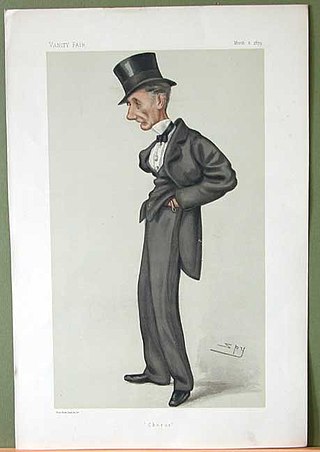Patrick Hepburn, 1st Earl of Bothwell was Lord High Admiral of Scotland. He rose to political prominence after supporting James IV against his father, and was proxy at the King's marriage.

Strathblane is a village and parish in the registration county of Stirling, situated in the southwestern part of the Stirling council area, in central Scotland. It lies at the foothills of the Campsie Fells and the Kilpatrick Hills on the Blane Water, 12 miles (19 km) north of Glasgow, 14 miles (23 km) east-southeast of Dumbarton, and 20 miles (32 km) southwest of Stirling. Strathblane is a dormitory village for Greater Glasgow, and has a total resident population of 1,811.
Janet Kennedy, was a Scottish noble and the mistress of King James IV of Scotland.

Alexander Elphinstone, 1st Lord Elphinstone was a Scottish peer. He was the son of Sir John Elphinstone of that ilk and of Pittendreich.
William Schaw was Master of Works to James VI of Scotland for building castles and palaces, and is claimed to have been an important figure in the development of Freemasonry in Scotland.
The Edmonstone Baronetcy, of Duntreath in the County of Stirling, is a title in the Baronetage of Great Britain. It was created 20 May 1774 for Archibald Edmonstone, 11th of Duntreath, Member of Parliament for Dunbartonshire and Ayr Burghs. He was succeeded by his third but eldest surviving son, the second Baronet. He represented Dunbartonshire and Stirlingshire in the House of Commons. On his death the title passed to his eldest son, the third Baronet. He was a writer and traveller. He died without surviving issue and was succeeded by his half-brother, the fourth Baronet. He was an admiral in the Royal Navy and Member of Parliament.

Castle Campbell is a medieval castle situated above the town of Dollar, Clackmannanshire, in central Scotland. It was the lowland seat of the earls and dukes of Argyll, chiefs of Clan Campbell, from the 15th to the 19th century, and was visited by Mary, Queen of Scots, in the 16th century. Mary was impressed by this and said "this reminds me of home".

Admiral Sir William Edmonstone, 4th Baronet CB, DL, also 14th of Duntreath, was a British naval commander, courtier and Conservative politician.

Glen Finglas is a glen in the Trossachs, in the Stirling council area of Scotland. It is an area of forest in Highlands of the former county of Perthshire, north of Brig o' Turk, close to Callander in Menteith. To the west is Loch Katrine.

The Douglases of Mains are a branch of the Clan Douglas, related to the Lords of Douglas through Archibald I, Lord of Douglas. The first Laird obtained land through marriage into the Galbraith family, which had been granted land in New Kilpatrick by Maldowen, Earl of Lennox. The family produced minor nobles in the Scottish court, perhaps the most notable of which was Malcolm Douglas, the 8th Laird, executed for treason in Edinburgh for conspiracy in the Raid of Ruthven. His second son, Robert Douglas, was made Viscount of Belhaven and is buried in Holyrood Abbey. The family intermarried in the Glasgow area, having links with the Campbells of Blythswood, with landed families across Scotland and more latterly the United Kingdom. The title became extinct in the 20th century; the last 33+1⁄2 acres of the estate was sold to Dunbartonshire county and was subsequently used for the erection of the secondary school, Douglas Academy, in Milngavie prior to the death of the last heir in 1977.
Clan Edmonstone is a Scottish clan which does not currently have a chief; therefore, it is considered an armigerous clan. However, Sir Archibald Bruce Charles Edmonstone, 17th of Duntreath is considered the Chieftain for the Edmonstones of Duntreath. It has been speculated that much, if not all, of the senior line of the Edmonstone Clan has died off. Most Edmonstones are believed to be descended from the Edmonstones of Duntreath.
James Stewart, 1st Lord Doune (1529-1590) was a Scottish landowner.
Archibald Wauchope of Niddrie Scottish landowner and rebel.
Sir William Livingstone of Kilsyth was a Scottish landowner and courtier.
James Edmonstone FRSE was a Scottish army officer and agriculturalist. He was a joint founder of the Royal Society of Edinburgh in 1783. He was a close friend of fellow founder David Hume.
Claud Hamilton of Cochno was a Scottish landowner and Captain of Dumbarton Castle.

Thornton Castle was a Scottish fortress belonging to the Montgomery family and subsequently Lord Home near Innerwick in East Lothian.

Records survive of the expenses made to feed the Scottish royal household in the sixteenth century, and the remains of royal kitchens can be seen in the ruins of palaces and castles. Archaeologists can recover evidence of diet from deposits including waste from meals and food preparation.
Mungo Graham of Rathernis was a Scottish landowner and courtier.

Elizabeth Sinclair was a servant of Margaret Tudor (1489-1541), the wife of James IV of Scotland.










